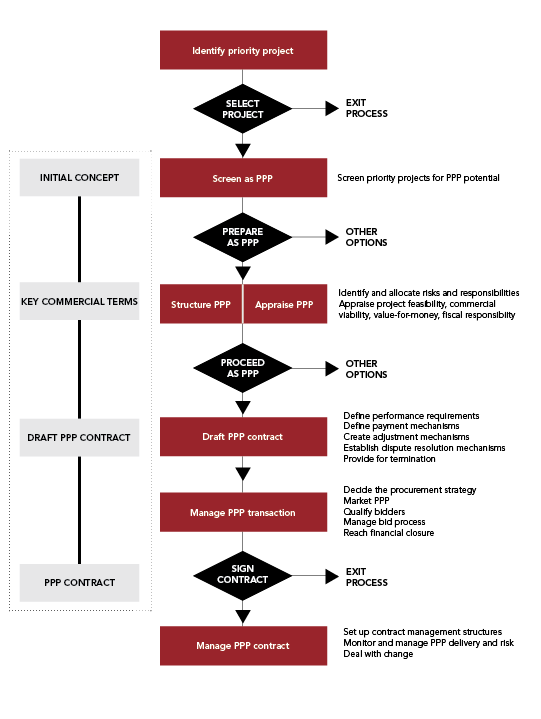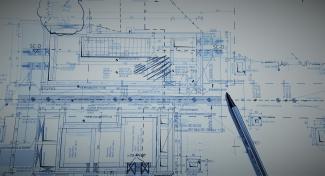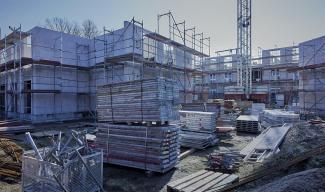Visit the PPP Online Reference Guide section to find out more.
Find it @ PPPLRC:
To find out more: Search the PPPLRC Library. Subscribe to the PPPLRC Newsletter. Contact us.
Visit the PPP Online Reference Guide section to find out more.
To find out more: Search the PPPLRC Library. Subscribe to the PPPLRC Newsletter. Contact us.
This module provides guidance on each stage of developing and implementing a PPP project—from identifying PPP candidates to managing contracts through the project life cycle. PPP Process introduced the overall PPP development and implementation process, also shown in PPP Development and Implementation Process below. This module describes each stage of the PPP process in more detail, providing links to resources, tools, and further guidance for PPP practitioners.

Governments should only develop PPP projects that are cost-benefit justified, provide better value for money than traditional public procurement, and are fiscally responsible. However, it is difficult to assess whether a project meets all these criteria until the project is fully designed, and the decision cannot be confirmed until bids are received. This creates a dilemma—government does not want to incur the considerable costs of developing a PPP unless it knows the project meets the criteria, but cannot tell if it meets the criteria until the project has been developed.
Successful PPP programs tackle this problem through an approach where projects are screened more rigorously at successive stage of development. A project must be a good candidate for development as a PPP before any public money is spent on it. Then, the process of preparation is broken into successively more intensive and expensive phases. Before each new phase, the project must be checked to provide assurance that it is likely to meet the criteria for successful PPPs as it develops.
This module describes the iterative process for developing a PPP, as follows:
Project identification and screening—the process of developing and implementing a PPP is typically preceded by identifying a priority public investment project, typically through a public investment planning and project selection process. During this process, some or all proposed public investment projects are screened for their potential as a PPP.
Candidate projects that survive this screening process are then developed and appraised. Again, this is a multi-stage process—hence appraisal and structuring are shown in parallel in PPP Development and Implementation Process. Because appraisal and structuring are conceptually different, the Reference Guide discusses appraisal first (Appraising Potential PPP Projects) and then structuring (Structuring PPP Projects). Projects will typically be partially structured, then partially appraised, then more fully structured, and more fully appraised. Different countries break up these steps differently. The result, or the business case for the project, is typically the basis for approval to proceed with the PPP transaction.
Before the PPP transaction can be implemented, the draft PPP contract needs to be prepared—further refining the PPP structure by setting out its details in appropriate legal language. Designing PPP Contracts sets out some key elements of PPP contract design.
Managing a PPP transaction is a complex process. A well-designed and well-implemented transaction process is central to achieving value for money from the PPP. As described in Managing PPP Transactions, this includes marketing the PPP, checking the qualifications of bidders, inviting and evaluating proposals, interacting with bidders during the process, and identifying and finalizing the contract with the selected bidder. At the end of the transaction, after bids are received and the contract agreed, government will finally know the cost and risks in the PPP project. At this point it may be checked once more to ensure it still meets the PPP criteria.
Having executed the contract, the PPP enters the final and longest stage—managing the contract throughout its lifetime, as described in Managing PPP Contracts.
As an alternative approach to originating and developing PPP project ideas, some governments accept unsolicited proposals for PPP projects from private companies, as described in Dealing with Unsolicited Proposals.
This guidance module is not an exhaustive resource—developing a PPP is a complex process and every project has its own peculiarities.
Public officials should hire experienced advisors when implementing a PPP project. The World Bank toolkit for hiring advisors for PPP in infrastructure (PPIAF 2001) provides extensive guidance on engaging and managing advisors.
As described in Establishing the PPP Framework, some governments and multilateral institutions, including the World Bank, have developed detailed guidance materials, manuals, and toolkits to help PPP practitioners develop and implement PPP projects. These include sector-specific materials. The Key References table on PPP on 'Other Guidance Material and Toolkits' list some of the best PPP guidance documents. Relevant sections are included as further resources for each PPP stage described in this Reference Guide.









Visit the PPP Online Reference Guide section to find out more.